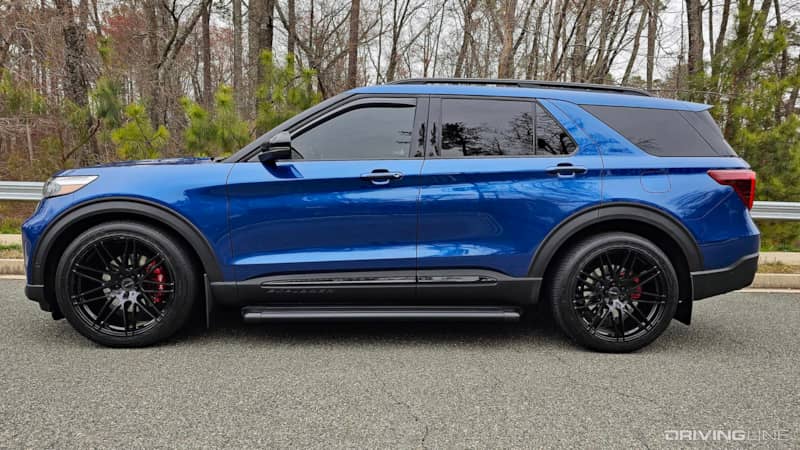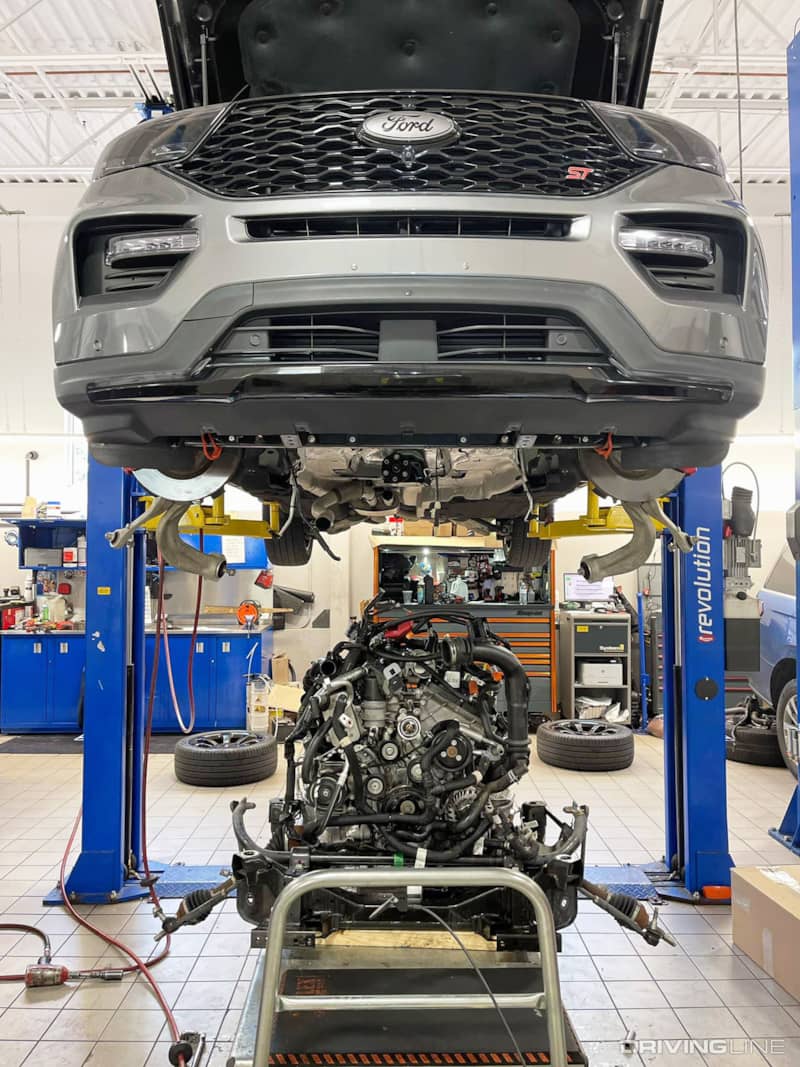Inside The 400 HP, Twin-Turbo 3.0L EcoBoost That Powers Ford’s Explorer ST
When it comes to Ford’s esteemed EcoBoost engines, the 3.5L V-6 used in its F-150 models typically gets all the love. On Raptor and Limited models, where 450 hp and 510 lb-ft of torque is on tap, the 3.5L is glorified even further. But what about the latest generation Explorer—the one that hasn’t had the 3.5L in common with America’s best-selling truck since 2020? Instead, the midsize SUV’s premium engine option is a twin-turbocharged 3.0L V-6. It isn’t a direct sibling of the 3.5L nor an exact replica of the 2.7L EcoBoost truck engines, as some believe, but in ST trim (Sport Technologies), the 180 ci, DOHC power plant produces a potent 400 hp and a seat-imprinting 415 lb-ft of torque.

Yet four years into production (seven years if you include its technical debut with Lincoln) little is known about what makes Ford’s twin-turbo 3.0L EcoBoost tick—and not even Ford is very forthcoming with details. Upon taking ownership of a ’22 Explorer ST last fall, the inquisitive mind of a gearhead took over and yours truly needed some answers. What size are the turbos? How strong are the rods? What are the nuts and bolts that make this parallel-turbo’d, small displacement V-6 so great? After a bit of digging and scrounging I found what I was looking for, and then some. Every spec you ever wanted to know about this engine is listed here, along with a few of its factory shortcomings.
3.0L EcoBoost Specs
| Engine Configuration: | 60-degree V-6 |
| Bore: | 3.36-inch (85.4 mm) |
| Stroke: | 3.39-inch (86.1 mm) |
| Displacement: | 180 ci |
| Compression Ratio: | 9.5:1 |
| Block: | Cast-aluminum lower with CGI (compacted graphite iron) upper |
| Heads: | Cast-aluminum |
| Valvetrain: | DOHC with variable camshaft timing (VCT), 4-valves per cylinder, roller finger followers |
| Camshaft Drive: | Chain-driven |
| Ignition: | Coil-on-plug |
| Firing Order: | 1-4-2-5-3-6 |
| Aspiration: | Twin-turbocharged, air-to-air intercooled |
| Throttle Body: | 2.4-inch (60 mm) |
| Fuel System: | High-pressure, direct injection (2,900-psi) |
| Crankshaft: | Forged-steel |
| Connecting Rods: | Forged-steel |
| Pistons: | Cast-aluminum |
| Exhaust System: | Dual 2.16-inch (55 mm) system with four 3-inch (76mm) chrome tips |
| Horsepower: | 400 hp at 5,500 rpm |
| Torque: | 415 lb-ft at 3,500 rpm |
| Redline: | 6,500 rpm |
| Dimensions (H x W x L): | 752 mm x 760 mm x 633 mm |
| Transmission: | 10R60 10-speed automatic |
Small Package, Big Power

Turning out better than 2.2 horsepower per cubic inch, the 3.0L EcoBoost V-6 in the ’20-present Ford Explorer ST is impressive. Its 400 hp is produced at 5,500 rpm while its noticeable 415 lb-ft of twist comes online at 3,500 rpm. Full disclosure: both of those ratings are only available on premium fuel (91 octane or higher). A slight horsepower penalty is paid when filling up with lower octane gasoline. In common V-6 EcoBoost fashion, the 3.0L features chain-driven, dual overhead camshafts, independent variable cam timing and four valves per cylinder.
Similarities & Differences With The 2.7L Nano Engine

While the 3.0L EcoBoost isn’t a direct derivative of the 2.7L truck and Bronco engine from the Nano family, there are similarities. Two big examples are that the composite intake manifold and the aluminum cylinder heads share the same part numbers. We presume this makes them interchangeable. However, their 60-degree blocks are noticeably different. The 2.7L’s crankcase is made from compacted graphite iron (CGI) while the 3.0L’s block features a CGI upper section—for superior strength in the combustion areas—but is otherwise cast-aluminum.
Robust Rotating Assembly

Inside the crankcase, it’s easy to see that the 3.0L EcoBoost was built to handle the stresses that come with a high performance, direct injection engine that’s boost-fed. Thanks to a comparison put together by ZFG Racing, we know that the 3.0L pistons boast an oil cooling gallery, which allows engine oil to be sprayed up into the bottom of the piston for optimum temperature control. The pistons in the 2.7L EcoBoost don’t enjoy this provision (but the 3.5L found in the Raptor and F-150 Limited do). According to ZFG Racing, the 3.0L piston’s skirt is also larger than the 2.7L version, with considerably more material under the wrist pin. A forged-steel crankshaft and forged-steel connecting rods provide further assurance the 3.0L EcoBoost is built for abuse.
39mm Turbos

On each bank of the 3.0L EcoBoost, you’ll find a turbocharger affixed to the exhaust manifold. The turbochargers, which are of the fixed geometry variety, are manufactured by BorgWarner but feature FoMoCo cast into the compressor housings. And being that the ST engine employs true twin-turbos (i.e. a parallel turbo configuration), each snail is sized exactly the same. They feature compressor wheels that measure 39.4 mm at the inducer. In stock form, the chargers produce a maximum boost pressure of 18 psi. Intake air temps are kept in check thanks to a factory air-to-air intercooler.
Performance Roadblock: The 10R60

The verdict is still out on the 10R60 automatic transmission’s threshold for pain. Presumably, Ford’s 10-speed slushbox will live just fine in a mod-free Explorer ST. But the kind of customer the ST attracts isn’t exactly the type to leave a vehicle stock. “Spirited driving,” combined with aftermarket tuning, intercooler, exhaust and air intake upgrades, can eventually lead to a slipping transmission and the need for better internals. For those looking to push the 3.0L EcoBoost to its horsepower limit, the 10R60 will be the first obstacle blocking the path. By comparison, the 10R80 automatic employed in the F-150 (as well as the Police Explorers) is known to be much stronger. Unfortunately converting to a 10R80 isn’t a direct swap possibility.
Common Mods

Speaking of mods, a larger intercooler is one of the first upgrades an ST owner makes when they begin to get serious about making more power. Luckily, Ford provided enough room behind the grille of its ’20-present Explorers to swap a significantly bigger intercooler into place. The aftermarket units sold by Whipple, Steeda, Mishimoto and CVF provide significant increases in core volume and external fin surface area, reduce restriction and can even drop intake temps as much as 115 degrees. Taking advantage of twin turbos and room to grow the intercooler, tuning also pays big dividends on the ST platform, a recipe that can easily crest 400 hp at the wheels. Tuning, intercooler and exhaust upgrades are most common, with die-hard owners taking things even further by getting into fuel system mods such as bigger injectors, along with upsized turbochargers.
Cam Phaser Issues

No review of an engine would be considered thorough without making mention of its most pressing issue(s). And since cam phaser failures can cost an Explorer ST owner an engine, that’s where we’ll start. When it happens you usually get a rattle, tick or tapping at cold-start, and then the noise gets progressively longer. Per Ford, cam phaser repair calls for 20 to 22 hours of labor. This entails pulling the engine (or maybe we should say pulling the body). However, and to be perfectly clear, the high-pressure fuel pump on the 3.0L EcoBoost is known to be a bit noisy, so it’s important not to mistake the HPFP’s normal operation for a cam phaser trying to check out…
Exhaust System Leaks

Factory exhaust leaks are a more frequent yet (thankfully) much less severe problem encountered by Explorer ST owners. Specifically, the flex pipes in the OEM system are known to begin leaking, and Ford issued a technical service bulletin (TSB) for the flex pipe issue, along with making mention that their respective brackets being part of the problem. Additionally, the factory catalytic converters are prone to cracking. Rattling and/or the always-unpleasant smell of exhaust in the cabin are common signs a cat has split. Ford issued a recall on select models to address the issue.
More From Driving Line
Looking for a 3-row SUV with some giddy-up? An Explorer ST vs. Hemi-powered Grand Cherokee L comparison likely isn’t on your list, but it should be. Here’s why.







